Day 1 : Arrive New Delhi
At the Indira Gandhi International Airport, a Trip to Holiday representative would meet guests outside the customs gate and transfer them to hotel.
Traditional Welcome - On arrival at the hotel, ladies in traditional saris greet guests with garlands of flowers and perform the “aarti-tikka” ceremony, followed by a non-alcoholic welcome drink, while the Registration formalities are carried on.
Meals included: None
Overnight at the hotel
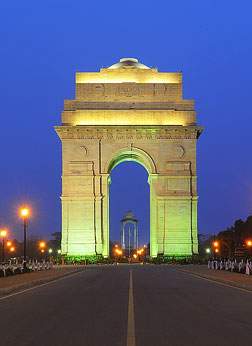 India Gate - Delhi
India Gate - Delhi
Day 2 : New Delhi
The city actually consists of two parts. Old Delhi was the capital of Muslim India between 17th and 19th century and has many mosques, monuments and forts. The other Delhi is New Delhi, the imperial city created as the capital of India by the British. Edwin Lutyens, the most renowned English architect of the day, was chosen to design New Delhi. His architectural conceptions were totally different from the Hindu or Mughal architecture. The city center has wide, straight avenues in a strict layout, plenty of parks and low colonial buildings with spacious gardens.
Morning will be at leisure.
This afternoon visit National Museum where you will find a great collection of Indian art and history. It is a meaningful representation of the culture and art of India to a foreigner. There are sculptures ranging from the period of Ashoka to the late medieval period, artifacts in bronze, terracotta and wood are drawn from all parts of the country relating to principal historic periods. An exhibit of Indian miniature paintings is remarkable.
Meals included: Breakfast
Overnight at the hotel
Day 3 : New Delhi
This morning visit Old Delhi, which has some dramatic remnants of the Mughal Empire. Enjoy a Rickshaw ride in the by-lanes of Old Delhi. Drive past the Red Fort and visit the Jama Masjid, India's largest mosque, both built by Emperor Shahjahan. Also visit Rajghat, the site of Mahatma Gandhi's cremation.
Post lunch, drive through the majestic boulevards of New Delhi which includes the grand government buildings and parliament house, the India gate and "Rashtrapati Bhawan" - the presidential palace. Also visit the 234-foot high Qutab Minar and Humayun's tomb, built in the 16th century by the second Mughal emperor, and is an early example of Mughal architecture.
Meals included: Breakfast
Overnight at the hotel
Day 4 : New Delhi - Varanasi
Transfer to domestic airport in time for your flight to Varanasi, considered to be the oldest living city in the world
Leave: Delhi at 10:40 hrs by 9W 723
Arrive: Varanasi at 11:50 hrs
On arrival, transfer to your hotel.
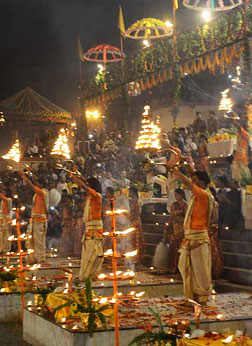 Ganga Aarti - Varanasi
Ganga Aarti - Varanasi
Varanasi is renowned for being the birthplace of the Hindu religion and has more than a thousand temples and shrines. Situated on the banks of the sacred Ganges, it has been a centre of learning and civilization for over 2000 years.
Post lunch, leave for an excursion to Sarnath. It was here that Lord Buddha first preached his message of enlightenment. Visit the ruins, the stupa, the Buddhist temple and the Archaeological museum (closed on Friday). Later visit Bharat Kala Kendra for the outstanding collection of textiles, paintings, stone sculptures and ancient terracotta.
This evening, witness an “aarti” (prayer) ceremony at the “ghats” (bathing steps) of the Ganges.
Meals included: Breakfast
Overnight at the hotel
Day 5 : Varanasi - Khajuraho
Rise at dawn for a boat ride to watch the priests chanting sacred verses, pilgrims taking a holy dip and the Hindus performing the last rights for the departed souls.
Return to hotel for breakfast.
Later visit the largest residential university in Asia - Benares Hindu University and then drive past the famous temples.
transfer to the airport in time for your flight to Khajuraho.
Leave: Varanasi at 12:20 hrs by 9W-723
Arrive: Khajuraho at 13:00 hrs
Meeting and assistance upon arrival and transfer to your hotel.
Khajuraho has always remained tucked away from the mainstream events of history. Once a great Chandela Capital, Khajuraho is now a quiet village. To preserve it for posterity, Khajuraho has been declared a World Heritage Site and is among the prominent destinations on the world tourism map.
The temples of Khajuraho are India’s unique gift to the world, representing, as they do, a paean to life to love, to joy; perfect in execution and sublime in expression. Architecturally they are unique, being very different from the temple prototype of their period.
This afternoon, visit the Southern group of temples and the Archaeological museum.
Meals included: Breakfast
Overnight at the hotel
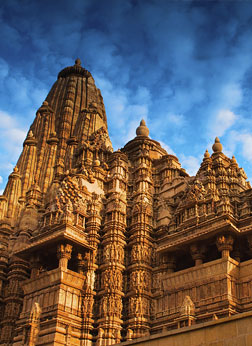 Khajuraho Temples
Khajuraho Temples
Day 6 : Khajuraho
This morning, visit the Eastern and Western group of temples.
Around the ancient little village of Khajuraho, are clustered some of the most unique monuments in the world and the magnificent temples, which make Khajuraho justly famous. From 9th to the 13th Century, it was the religious and political capital of the Chandela Kings, who between 950 AD - 1050 AD built here a complex of 85 temples. Decorating the walls and platforms of the 22 temples still remaining are sculptures, both sublime and sensual, of remarkable grace and beauty. The temples dedicated to various gods and goddesses bear friezes depicting not only celestial beings but also portraying the everyday life and culture of a highly civilized people. The erotic theme prevails in an array of sculptures of amorous couples in the most intimate and extraordinarily varied postures of sensual love.
Afternoon at leisure or repeat your visit to the temples.
Meals included: Breakfast
Overnight at the hotel
Day 7 : Khajuraho - Orchha
Morning drive to Orchha covering a distance of 170 kms in approximately 4 hours. On arrival check-in at your hotel.
Orchha - Overlooked by the modern era, this beautiful medieval town was once the capital of the Bundela Kings. Built along the banks of the river Betwa, flowing through a rugged countryside, Orchha still retains the captivating air of a bygone era.
Afternoon visit Orchha Palace, built in 17th century. Amongst the various imposing edifices, of particular interest are the Jehangiri Mahal, built by Raja Bir Singh Deo to commemorate the visit of Mughal Emperor Jehangir, the Raj Mahal and the Laxminarayan temple, both noted for their fine frescoes and mural paintings.
Meals included: Breakfast
Overnight at the hotel
Day 8 : Orchha - Jhansi - Bhopal
After breakfast, transfer to the railway station in time to board Shatabdi Express for Bhopal.
Leave: Jhansi at 10:32 hrs by Shatabdi Express
Arrive: Bhopal at 14:10 hrs
Bhopal the capital of Madhya Pradesh was one of the prominent princely states of India and imposing monuments speak of its history. It is a fairly laid-back city and therein lays its charm. The lakes follow you everywhere, the air is clear and the traffic uncluttered. Today it presents a multi-faceted profile: the old city, with its teeming market-places, fine old mosques and palaces, still bears the aristocratic imprint of its former rulers, among them the succession of powerful begums who ruled over Bhopal from 1819 to 1926. Equally impressive is the avenues and streamlined modern edifices.
Upon arrival at Bhopal station, commence the sightseeing tour, which would include a visit to some of the important mosques- Taj-ul-Masjid and Jama Masjid. Also visit Bharat Bhavan and Tribal Habitat.
Meals included: Breakfast
Overnight at the hotel
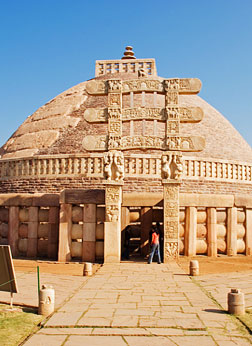 Sanchi Stupa - Sanchi
Sanchi Stupa - Sanchi
Day 9 : Bhopal - Sanchi - Bhopal
Full day excursion to Sanchi covering a distance of 67 Kms in 1½ hour.
Sanchi is known for it’s Stupa, monasteries, temples and pillars dating back from the 3rd century BC to the 12th century AD. The renowned Sanchi Stupa built by Emperor Ashoka is the most famous of all the Stupa.
This group of Stupa and monasteries constitute one of the most important Buddhist sites in India and is included in the World Heritage list. Carved with stories of Buddha’s past and with incidents from the subsequent history of Buddhism, the gateways are the finest specimens of early classical art, which formed the seedbed for the entire vocabulary of later Indian art. The inscriptions on the gateways mention donors from all over northern India and notable are the inscriptions crafted by the ivory workers of Vidisha, who worked with the precision implied by the jewelry workers of the yesteryears.
Later drive back to Bhopal.
Meals included: Breakfast
Overnight at the hotel
Day 10 : Bhopal - Agra
Morning excursion to Bhojpur, named after it’s founder- the legendary Parmar king Raja Bhoj. Bhojpur is renowned for it’s remains of the magnificent Shiva Temple and the Jain Shrine. The Shiva temple is also called the “Somnath of the East” and was never completed but it still manages to capture the essence of the period. Nearby is another incomplete monolithic temple, a Jain Shrine containing a colossal statue of Mahavira over six meters tall.
Time permitting, visit Bhimbetka caves, a UNESCO World Heritage site. 00 rock shelters belonging to the Neolithic age. The highlights here are the paintings on the walls of the caves, which depict the life of the pre-historic cave dwellers.
Post lunch, transfer to the railway station in time to board Shatabdi Express for Agra.
Leave: Bhopal at 14:50 hrs by Shatabdi Express
Arrive: Agra at 20:10 hrs On arrival, transfer to your hotel.
Meals included: Breakfast
Overnight at the hotel
Day 11 : Agra
Agra is globally renown as the city of the Taj Mahal. But this royal Mughal city has, in addition to the legendary Taj, many monuments that epitomize the high point of Mughal architecture. In the Mughal period, in the 16th and 17th centuries, Agra was the capital of India. It was here that the founder of the dynasty, Babar, laid out the first formal Persian garden on the banks of the river Yamuna.
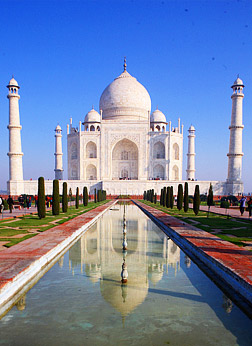 Taj Mahal - Agra
Taj Mahal - Agra
This morning visit the Taj Mahal by sunrise. With its incredible lacy white grandeur and loveliness is perhaps the most perfect architectural monument in the world. Emperor Shahjahan constructed this most famous and incomparable Moghul monument in memory of his beloved wife Mumtaz Mahal. It is the most extravagant monument ever built for love. The Taj Mahal is amazingly graceful from almost any angle and it is the close up detail, which is really astounding.
Please note: The Taj Mahal remains closed on Friday.
Return to the hotel for breakfast and later visit Sikandra, the final resting place of Emperor Akbar. The tomb of Akbar shows an interesting fusion of Hindu and Mughal architecture. Akbar began the construction of his own garden mausoleum during his lifetime. His mausoleum is a red sandstone structure in a four square formal garden.
Post lunch, visit the Agra Fort. It was built by the third Mughal Emperor, Akbar, and added to by his son Jehangir and grandson Shahjahan. Agra Fort is an imposing structure with walls of red sandstone, almost two miles long and contains palaces, audience halls and mosques built by all the three emperors. The fort presents a good sampling of Islamic and Hindu architectural styles. Also stop at Itimad- ud- daulah, the tomb of Mirza Ghiyas Beg, the wazir (Chief Minister) in Jehangir’s cabinet. Mirza’s beautiful daughter, Nurjahan later married Emperor Jehangir’s son, Shah Jahan.
Meals included: Breakfast
Overnight at the hotel
Day 12 : Agra - Jaipur
After an early morning optional visit to the Taj to watch the sun rising over its white marble domes, drive to Jaipur with an en-route stop at Akbar’s abandoned capital of Fatehpur Sikri. (221kms/ 8 hours approximately).
Evening arrive in Jaipur and check in to your hotel.
Meals included: Breakfast
Overnight at the hotel
Day 13 : Jaipur
Jaipur, popularly known as the Pink City, is the capital of the state of Rajasthan. The old city of Jaipur is partially encircled with seven gates - the major gates are Chandpol, Sanganer, and Ajmer. The 'pink city' label, applies specifically, to the old walled quarter of the Rajasthani capital, while in the northeast of the town, glorious palaces and temples, in an assortment of styles, spanning centuries, are scattered throughout the, predominantly, urban area. Jaipur is a tourist's delight. It is an extremely colorful city, and in the evening light, the pink and the orange buildings exude a magical glow, which is complemented by the vibrantly attired Rajasthanis. Camel drawn carts are characteristic of Jaipur's passing street scene.
This morning sightseeing tour of Jaipur, “abode of rajahs”. Ascend to Amber Fort on elephant back. Tour the chambers and hallways of the palace, famous for the excellence of its design and decoration. Within the complex is Ganesh Pol, an imposing gateway painted with the images of the elephant-headed god, Ganesh. The merging of Rajput and Mughal architectural styles is captured in the Sukh Niwas and Jas Mandir apartments, and the Charbagh garden with its perfectly proportioned landscaping. Pierced screen windows offer views from different vantage points, and shimmering mirrors encrust the walls of Sheesh Mahal.
Remainder of the afternoon will be at leisure.
Meals included: Breakfast
Overnight at the hotel
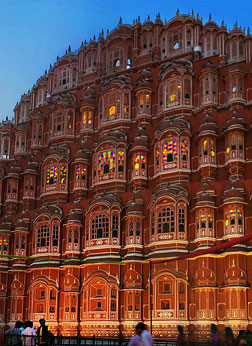 Hawa Mahal - Jaipur
Hawa Mahal - Jaipur
Day 14 : Jaipur
This morning visit the Observatory, which was built in the 1700s but still appears to be futuristic; the City Palace and its museum; the Hawa Mahal or the "Palace of the Winds."
This beautiful façade is probably the most-photographed in Jaipur, with its ornately carved windows designed so the ladies of the palace could look out onto the streets unobserved. There is also time to shop for Jaipur blue pottery and block-printed cotton linens.
Rest of the afternoon at leisure for independent activities. During this free afternoon, we would recommend an optional visit to Sanganer. Sanganer is 12kms south- west of Jaipur and the road into this small town pass through two ruined triple gateways, beyond which is the ruined palace and old Jain temples. It is famous for papermaking and screen/ block printing. You would get a first hand experience to watch the skilled craftsmen at work and an opportunity to purchase samples at perhaps one-fourth the price of that available in Jaipur.
Meals included: Breakfast
Overnight at the hotel
Day 15 : Jaipur - Khimsar
This morning drive to Khimsar covering a distance of 260 kms in approximately 7 hours, including a two-hour stop at Nagaur for lunch and to visit the fort. The historic Nagaur Fort encompasses an ancient complex of richly painted palaces, mosques, temples, intricate reservoirs, fountains, open terraces and pleasure gardens dating back to Mughal era.
After lunch, continue your drive to Khimsar and on arrival, check-in at - Khimsar Fort.
Khimsar is beautifully located in the middle of a small village, just off the Jodhpur highway. In the far distance are sand dunes that shelter fields where black buck can be spotted grazing. Established in the 15th century by a scion of the house of Jodhpur, its history is a mixed one, reflected in the architecture of its fortified castle.
Meals included: Breakfast, Lunch and Dinner
Overnight: Khimsar Fort
Day 16 : Khimsar - Jaisalmer
This morning drive to Jaisalmer covering a distance of 220kms in approximately 5 hours, including a one-hour stop at Pokran Fort. On arrival check in to your hotel.
One of Rajasthan's most alluring cities, Jaisalmer, deep in the heart of Thar Desert, abounds in ancient palaces, temples and quaint settlements. Very few cities can, even hope to match the sheer grandeur of this city. There is an indefinable aura of magic and mystery, that surrounds its famous desert-fortress - the yellow sandstone walls and bastions of which, take on a golden hue in the afternoon sun, which is why it is, so aptly, called Sonar Kila or the Golden Fort.
Rest of the afternoon at leisure for independent activities.
Meals included: Breakfast
Overnight at the hotel
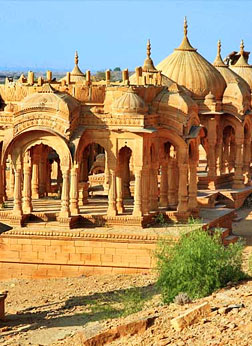 Bada Bagh - Jaisalmer
Bada Bagh - Jaisalmer
Day 17 : Jaisalmer
This morning visit the 12th century Jaisalmer Fort, rising out of the sea of sand with its rounded battlements of golden sandstone, echoing the colour of the desert. Walking down the narrow cobbled stone lanes, you will feel the magnetism of Jaisalmer. Outside the fort, is the main market place from where you can walk into the lanes, where the famous carved Havelis are to be found.
Late afternoon, visit an ethnic village in Khuri, situated 40kms from Jaisalmer. Enjoy a camel ride at this picturesque desert village to view the sun set.
Meals included: Breakfast
Overnight at the hotel
Day 18 : Jaisalmer - Jodhpur
This morning drive to Jodhpur covering a distance of 270 kms in approximately 6 hours, with a one-hour stop at Osian, a picturesque Thar Desert town. Osian was a great trading centre between the 8th and 12th centuries when the Jains dominated it. The wealth of Osian’s medieval inhabitants allowed them to build lavish and exquisitely sculptured temples, most of which have withstood the ravages of time.
After a brief stop at Osian, continue your drive to Jodhpur and on arrival, check in at your hotel.
Rao Jodha, a chief of the Rathore clan of the Rajputs, founded the city of Jodhpur on the edges of Thar Desert in 1459 A.D. Popularly known as the “Blue City”, Jodhpur was the capital of the Rathore Kingdom and the second largest city in Rajasthan after Jaipur. The pride and joy of Jodhpur - the temples, monuments and gardens depict a multi-faceted grandeur. The exquisite handicrafts, folk dances, music and the brightly attired people lend a romantic aura to the city.
Rest of the afternoon at leisure.
Meals included: Breakfast
Overnight at the hotel
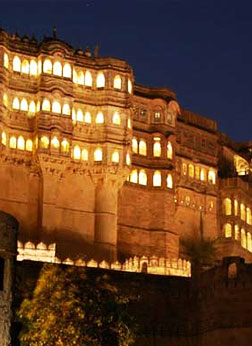 Mehrangarh Fort - Jodhpur
Mehrangarh Fort - Jodhpur
Day 19 : Jodhpur
This morning, visit Mehrangarh fortress, which is an awesome looking structure rising out of the red stone hill as if it were an extension of it. The fortress occupies an impressive acropolis, dominating the scrubland for miles. Also visit the stately sandstone, Umaid Bhawan Palace. At the Palace, you get an opportunity to view the Maharaja’s private collection of antiques and artifacts.
This afternoon, visit Mandore, the former capital of Marwar. Worth seeing are the old cenotaphs and caves in the crags which once sheltered the ascetics. The exquisitely landscaped gardens are teeming with a variety of birds and small animals. The lush greenery set to music against the gurgling fountains is truly a sight to behold.
Meals included: Breakfast
Overnight at the hotel
Day 20 : Jodhpur - Ranakpur - Udaipur
This morning drive to Udaipur, covering a distance of 260kms in approximately 6 hours. Enroute visits the famous Jain Temple of Ranakpur, dating back to the 15th century. Its 200 pillars, none of which are alike, support 29 halls. The Temple abounds with intricate friezes and sculptures.
After the visit continue your drive to Udaipur. On arrival check in at your hotel.
Meals included: Breakfast
Overnight at the hotel
Day 21 : Udaipur
Udaipur, the city combines real beauty with a picturesque association of a great and glorious past. It stands in a valley, amidst green hills on the banks of the wide, steel blue Lake Pichola. Possibly no city in Rajasthan is quite as romantic as Udaipur and is replete with fantastic hill top fortresses, exotic fairy tale palaces and gripping legends of medieval chivalry and heroism. Udaipur rivals any of the world's famous creations of the Moghuls with the Rajput love of the whimsical and it's superbly crafted elegance.
This morning’s sightseeing includes a visit to Eklingji & Nagda Temple. Located 14 miles from Udaipur, Eklingji & Nagda temple is chiseled out of sandstone and marble and is a complex of 108 temples enclosed by high walls. It was built in 734 AD and is dedicated to Lord Shiva. The roof is decorated with circular knobs and is crowned by a lofty tower. Nagda, now in ruins, was the scene of frequent Muslim invasions. It also has two 11th century temples ornamented with unusual carvings.
Afternoon, sightseeing includes a visit to the City Palace, a conglomeration of buildings added by various Maharanas. The palace manages to retain a surprising uniformity of design. The entrance is through Hathi Pol (elephant gate) along the main street of the old city, past the Jagdish Temple. The paintings, mosaics, intricately carved ‘chhatries’ and of course the architecturally brilliant façade all contribute in making a visit to the City Palace a truly memorable experience.
Also visit the lovely Sahelion-ki-Bari, the Garden of the Maids of Honour was constructed for forty-eight young ladies in waiting who were sent to the royal house as a part of the lavish dowry.
Meals included: Breakfast
Overnight at the hotel
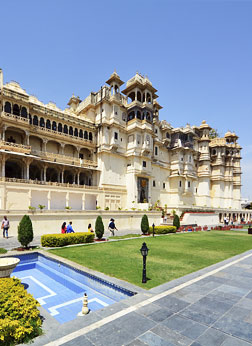 City Palace - Udaipur
City Palace - Udaipur
Day 22 : Udaipur
Full day at leisure for independent activities- shopping, etc or enjoy a walk in the colorful city of Udaipur.
Late afternoon, enjoy a boat cruise on the placid waters of Lake Pichola. Also visit the Jag Mandir Palace, built by Maharana Karan Singh in 1622 AD as a pleasure palace for royal parties and functions. This magnificent monument with its domes, marble pillars and fountains has a special approach of a row of marble elephants that seem to be guarding the island.
Meals included: Breakfast
Overnight at the hotel
Day 23 : Udaipur - Delhi
This morning wake up at leisure and later transfer to the airport in time for your flight to Delhi -
Leave: Udaipur at 15:30 hrs by 9W-708
Arrive: Delhi at 16:40 hrs
Meeting and assistance upon arrival and transfer to your hotel.
Remainder of the afternoon will be at leisure. Later transfer to international airport in time for you homebound flight.
Meals included: Breakfast
Overnight at the hotel
Day 24 : Leave New Delhi
Leave New Delhi